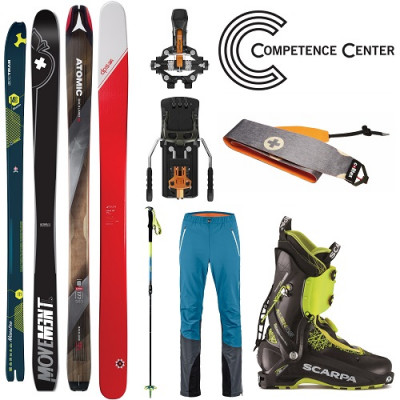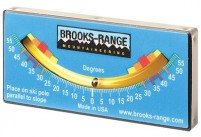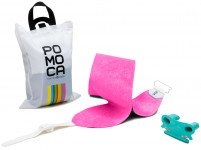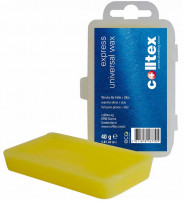10/27/2017 A Racer's Secret: The Inclined Plane
By Jason Borro, Skimo Co Owner
We’ve decided to let you in on a little secret. A secret known only to skimo racers, paraplegics, high-school physics teachers, and the rare students who retain knowledge after the test. The secret is a simple machine known as the Inclined Plane, shown below.
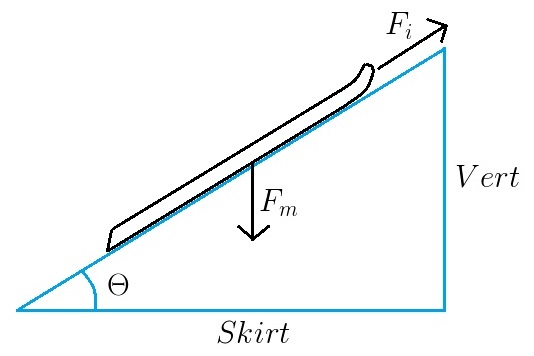
Like all machines, the Inclined Plane provides a mechanical advantage. In this case, the advantage is defined by the ratio of an object’s weight (Fm) divided by the force needed to pull it up a mountain (Fi). If you vertically lifted your skis, boots, and bindings every step, you will need to apply a force equal to the combined weight of your gear. However, if you slide it up an inclined plane, the force required will be less. The resulting mechanical advantage (MA) is defined as follows:

As is evident in the above formula, the advantage provided by the Inclined Plane is inversely related to the slope angle, theta. That angle is calculated as the arctangent of a mountain’s Vert (height) and its Skirt (if you somehow skirted to its center):

It should now be clear why guys and gals in skin suits prefer lower angle tracks. The lower the Vert-to-Skirt ratio, the greater the mechanical advantage. Those wise old tight-wearers are using an Inclined Plane to cheat the game of life. This is the simple but eye-opening secret.
If you have skins with decent glide, or even optimize for that quality, you can really use the slope of the mountain to your advantage. It can take time to train your muscles to perform a sliding motion instead of a stepping motion, but the results are longer, more enjoyable days.
Please share this secret with your slow friends.
Disclaimer: The above formulas represent a frictionless inclined plane. The force to pull a ski along the plane (Fi) increases as friction increases. With certain nylon skins at certain slope angles, the mechanical advantage of the inclined plane might be entirely negated. This possibly explains why some folks naturally stomp up the mountain instead of slide.
Comments
Here are the equations to relate the given analysis above to work, W.
W = force x distance.
From the given analysis above,
Fm/Fi = 1/sin(theta), therefore Fi = Fm*sin(theta)
For the Fm case,
Wm = Fm*vert (where Wm is work for the vertical skin track, i.e., for Fm)
For the Fi case,
Wi = Fi*di, where di is the distance up the skin track to gain vert elevation
now, di = vert/sin(theta) so
Wi = Fi*vert/sin(theta)
substitute Fm*sin(theta) for Fi and we have
Wi = Fm*sin(theta)*vert/sin(theta) = Fm*vert = Wm
So the work is the same in both situations. Add in friction, and the work in the 'i' case becomes larger. This is why cyclists typically gain elevation more rapidly (higher VAM) on steeper slopes, so long as the slope isn't so steep that gearing and traction become a problem (same skiing of course, sliding back down a skin track isn't very efficient!)
Yes, in both cases the Work done is the same. However, that does not mean that your muscles are equally spent after each effort. Just like lifting your maximum weight versus doing many reps, or sprinting instead of running a marathon, you will notice faster fatigue with the greater effort. Experience tells us that we can accomplish more Work over a long period of time with fast skins and low angle tracks!
- the most important is the limits given by the vertical component of your weight you are able to lift at high speed (known as your Power !). On this just dooping really well works (Amstrong teach);-P
- the biomechanic skier/boot-ski-binding against Slope Ration also play an important rule: is not possible to slide on a too steep slope,
- than you will see traditiona binding racers decreasing gait's length so rise the gait's frequence and lift their ski (as less as possible)
- while Natural Walking Plate Skiers will not suffer of this problem: https://www.youtube.com/watch?v=QgHYq3POdy0
- We prove the little extra weight of the NWP is nothing compared to the comfort given by the Natural Stride and the better grip of the skins on any kind of slope (especially when is very steep). NWP-Race will assure a faster start and faster walking with zero back/feet pain problems. Try to believe !
Here the difference on a short fast test:
https://www.youtube.com/watch?v=YXKsk6Lcx7c
More videos on youtube: search for Stefano Maruelli channel,
or goto: n-w-b.com
and ask to Skimo Co for our products !
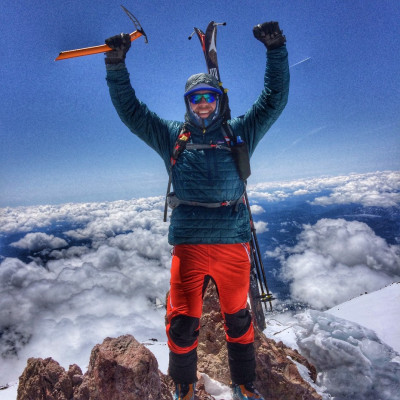
11/7/2017
Little time, Lots of fun
